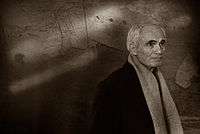Tigran Mansurian

Tigran Yeghiayi Mansurian (Armenian: Տիգրան Մանսուրյան; born 27 January 1939) is a leading Armenian composer of classical music and film scores.[1][2]
Biography
Mansurian was born in Beirut. His family moved to Armenia in 1947 and settled in Yerevan in 1956, where he was educated.[3] He studied first at the Romanos Melikian Music School under the Armenian composer Edvard Baghdasaryan and later at the Yerevan Komitas State Conservatory.[4][5] His "Monodia" album was nominated for the 2005 Grammy Award for "Best Instrumental Soloist(s) Performance (with Orchestra)" and "Best Classical Contemporary Composition."[6]

Recordings
- Tigran Mansurian: String Quartets - Rosamunde Quartett (ECM 1905)
- Tigran Mansurian: "…and then I was in time again", Lachrymae, Confessing with Faith – Kim Kashkashian, viola; Jan Garbarek, soprano saxophone; The Hilliard Ensemble; Christoph Poppen, conductor; Münchener Kammerorchester. (CD ECM 1850/51)
- Tigran Mansurian: Havik, Duet for viola and percussion – Kim Kashkashian, viola; Robyn Schulkowsky, percussion; Tigran Mansurian, piano, voice. (CD ECM 1754)
- Tigran Mansurian: Quasi parlando - Patricia Kopatchinskaja, violin; Anja Lechner, violonchello; Amsterdam sinfonietta; Candida Thompson. (ECM new series 2323)
Works
Mansurian's compositions range from large scale orchestral works to individual art songs. He also composed several film scores between 1968 and 1980.[7] In 2017, Tigran Mansurian released an album entitled Requiem, a collection of eight pieces "Dedicated to memory of the victims of the Armenian Genocide."[8]
Stage
- The Snow Queen (ballet in two acts with a scenario by Vilen Galstyan, after the story by Hans Christian Andersen), 1989
Orchestral
- Concerto, for organ and small orchestra, 1964
- Partita, for large orchestra, 1965
- Music for Twelve Strings, 1966
- Preludes, for large orchestra, 1975
- To the Memory of Dmitry Shostakovich, for cello and large orchestra, 1976
- Canonical Ode, for harp, organ and 2 string orchestras, 1977
- Concerto No. 2, for cello and string orchestra, 1978
- Double Concerto, for violin, cello and string orchestra, 1978
- Tovem, for small orchestra, 1979
- Nachtmusik, for large orchestra, 1980
- Because I Do Not Hope (in memory of Igor Stravinsky), for small orchestra, 1981
- Concerto, for violin and string orchestra, 1981
- Concerto No. 3, for cello and small orchestra, 1983
- Postludio Concerto, for clarinet, cello, string orchestra, 1993
- Concerto, for viola, and string orchestra, 1995
- Fantasy, for piano, string orchestra, 2003
- Ubi est Abel frater tuus? Concerto No.4, for cello and small orchestra, 2010
Chamber music
- Sonata, for viola and piano, 1962
- Sonata, for flute and piano, 1963
- Sonata No. 1, for violin, piano, 1964
- Allegro barbaro, for solo cello, 1964
- Sonata No. 2, for violin and piano, 1965
- Piano Trio, for violin, cello, and piano, 1965
- Psalm, for two flutes and violin, 1966
- Interior, for string quartet, 1972
- Silhouette of a Bird, for harpsichord and percussion, 1971–73
- Sonata No. 1, for cello and piano, 1973
- Sonata No. 2, for cello and piano, 1974
- Wind Quintet, for flute, oboe, clarinet, French horn, and bassoon, 1974
- The Rhetorician, for flute, violin, double bass, and harpsichord, 1978
- Capriccio, for solo cello, 1981
- String Quartet No. 1, 1983–84
- String Quartet No. 2, 1984
- Five Bagatelles, for violin, cello, and piano, 1985
- Tombeau, for cello and percussion, 1988
- Postludio, for clarinet and cello, 1991-92 (also has a concerto version)
- String Quartet No. 3, 1993
- Concerto, for English horn, clarinets, bassoons, trumpets, and trombones, 1995
- Hommage à Anna Akhmatova, for bass clarinet, qanun (zither), viola, and marimba, 1997
- Duo, for viola and percussion, 1998
- Dance, for viola and percussion, 1998
- Lacrimae, for soprano saxophone and viola, 1999;
- Lamento, for violin, 2002 (also has version for viola)
- Three Medieval Taghs, for viola and percussion, 1998–2004
- Testament, for string quartet, 2004
- Ode an den Lotus (Ode to the Lotus) for viola solo, 2012
Piano
- Sonatina No. 1, 1963
- Petite Suite, 1963
- Sonata No. 1, 1967
- Miniatures, 1969
- Three Pieces, 1970–71
- Nostalgia, 1976
- Three Pieces for the Low Keys, 1979
- Sonatina No. 2, 1987
Choral
- Three Poems, for mixed chorus, 1969 (text by Kostan Zaryan)
- Spring Songs, for mixed chorus, 1996 (text by Hovhannes Tumanyan),
- Confessing with Faith, for four male voices and viola, 1998 (text by Nerses Shnorhali)
- Ars Poetica concerto for mixed chorus, 1996–2000 (text by Yeghishe Charents)
- Motet, two mixed choruses, 2000 (text by Grigor Narekatsi),
- On the Shores of Eternity, for mixed chorus, 2003 (text by Avetik Isahakyan)
Vocal
- Three Romances, for mezzo-soprano and piano, 1966 (text by Federico García Lorca, translated into Armenian by Hamo Sahyan)
- Four Hayrens for mezzo-soprano (or viola) and piano, 1967 (text by Nahapet Kuchak)
- Intermezzo, for soprano and ensemble, 1972-73 (text by Vladimir Holan), score lost)
- I am Giving You a Rose, for soprano, flute, cello, and piano, 1974 (text by Matevos Zarifyan)
- Three Nairian Songs, for baritone and large orchestra, 1975–76 (text by Vahan Teryan)
- Three Madrigals, for soprano, flute, cello, piano, 1974–81 (text by Razmik Davoyan),
- Sunset Songs, for soprano and piano, 1984–85 (a song-cycle to text by Hamo Sahyan)
- The Land of Nairi for soprano and piano, 1986 (a song-cycle to text by Vahan Teryan),
- Miserere, for soprano and string orchestra, 1989 (texts by Saint Mesrob based on the Bible in Armenian translation)
- Madrigal IV, for soprano, flute, clarinet, violin, cello, piano, and tubular bells, 1991 (text by Alicia Kirakosyan)
- Requiem, for soprano, baritone, mixed chorus and string orchestra, 2011
Film scores
- The Color of Pomegranates, 1968 (directed by Sergei Parajanov)
- The Color of Armenian Land, 1968 (directed by Mikhail Vartanov)
- Autumn Pastoral, 1971 (directed by Mikhail Vartanov)
- And So Every Day, 1972 (directed by Mikhail Vartanov)
- We and Our Mountains, 1969 (directed by Henrik Malyan)
- Osenneye solntse (Autumn Sun), 1979 (directed by Bagrat Oganesyan)
- Legend of the Clown, 1979 (directed by Levon Asatryan)
- Ktor me Yerkinq, 1980 (directed by Henrik Malyan)
- The Tango of Our Childhood, 1984 (directed by Albert Mkrtchyan)
References
- ↑ "Tigran Mansurian". ECM Records. Retrieved 17 March 2014.
In only a few years he became one of Armenia’s leading composers.
- ↑ Swed, Mark (19 January 2009). "Review: The Dilijan series premieres a new Tigran Mansurian work". Los Angeles Times. Retrieved 17 March 2014.
- ↑ "Los Angeles Times published article dedicated toTigran Mansurian". Armenpress. 10 January 2014. Retrieved 17 March 2014.
- ↑ Schott Music, Tigran Mansurian
- ↑ Pasles, Chris, What stirs deep inside , Los Angeles Times, 20 April 2007
- ↑ Tigran Mansurian
- ↑ Works list compiled from The Living Composers Project, Mansurian, Tigran
- ↑
External links
- Tigran Mansurian's official web page
- Tigran Mansurian on Other Minds Festival website
- Tigran Mansurian-Confessing With Music Documentary Film